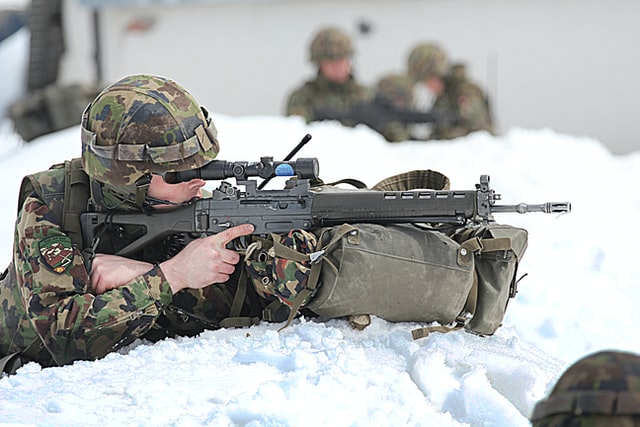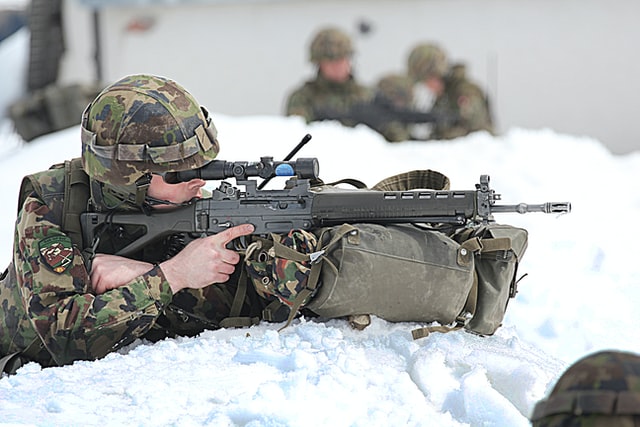Military exercises are held regularly by armed forces throughout the world. An exercise can be seen as an act of diplomacy, a direct threat, a demonstration of military capability for deterrence or – in the case of Nato – an expression of unity.

In purely military terms, exercises allow different nations’ armed forces to act in cooperation. They are useful for testing plans for deployment, reinforcement and logistics. New weapon systems and doctrines can be tried out in the field in as close to combat conditions as possible.
As Nato’s Cold Response 2022 exercise takes place in Norway, it may look like Nato is preparing to reinforce its troops already in Europe following Russia’s invasion of Ukraine. That is a possibility, but it was not the aim when the exercises were planned last year. Cold weather training is vital for military forces, and Norway has often been used by Nato for this type of preparation. Cold Response 2022 is a continuation of biannual exercises held in Norway since 2006. Publicised in June 2021 and notified to the Russians in January 2022, it was planned before the Russian invasion in February.
Both Nato and Russia – or previously the Soviet Union and the Warsaw Pact countries – notify each other of large exercises precisely to avoid them being seen as a threat. The Helsinki Accords, signed in 1975 under the Conference on Security and Co-operation in Europe (CSCE), were followed by the Document of the Stockholm Conference, 1986. This required notification by the host nation of any exercise involving more than 13,000 personnel or 300 battle tanks.
Since 1990, under the Organization for Security and Co-operation in Europe’s (OSCE) Vienna Document, exercises must be revealed by their host nations to OSCE member states 42 days in advance if exceeding 9,000 personnel. Observers from OSCE member countries are invited to watch the exercises to maintain transparency and reduce the chances of a mistake.
Cancelling such an exercise would be seen as unusual – it would break the cycle and indicate a change in Nato operations. What would be more unusual – and escalatory – would be for the troops involved in the exercise to remain in Norway once the exercise is over. Some of the forces involved, such as Nato’s Maritime High Readiness Force, are intended for rapid response. So while this exercise is planned, circumstances make it serendipitous for Nato if it wants to respond to Ukraine in a firmer way. The alliance has a large numerical and qualitative advantage. What is less certain is the political willingness to climb the escalatory ladder.
Exercises as cover
Nato has made it very clear that the exercise is not a response to the Russian invasion of Ukraine. But the use of exercises to cover preparations for a military intervention is not new. The Soviet Union used exercises to cloak its preparation for the invasion of Czechoslovakia in 1968. And Russia and Belarus held military “drills” prior to the invasion of Ukraine in February.
These followed on from Zapad-21, a Russian and Belarusian military exercise held in Belarus and the Western Military District of Russia, in September 2021. Russia also held naval exercises in the Black Sea and Sea of Azov, as well as off the Irish coast, in February 2022. This caused severe disruption to commercial shipping in the Black Sea.
In response to the Russian “drills” in February 2022, Ukraine began its own “drills”. This demonstrated how exercises in a period of tension can lead to an escalatory spiral. In this instance, though, the Ukrainians were right to mobilise their forces, even partially.
New cold war
During the cold war, Nato exercises were held regularly to test the speed at which reinforcements could be moved onto the continent from North America and Britain. The US part was known as REFORGER (Reinforcement or Return of Forces in (or to) Germany) and military equipment was kept in storage in Europe, ready for the personnel to arrive and prepare for war.
In 2020, Exercise Defender was undertaken for a similar purpose by the US, with Nato involvement. Since 2014, the US has kept an armoured brigade combat team and a combat aviation brigade in Europe. There is another exercise currently active in Lithuania – Rising Griffin – with more Nato exercises to come.
The problem with reinforcing Europe from Britain and North America is the Atlantic and English Channel. The sea and air routes are easily interdicted by enemy submarines and aircraft – and Russia still has this capability. Action against the movement of troops would delay any reinforcement and result in a serious loss of life.
If Nato leaders agreed to keep the troops in Europe after the exercise this would be a clear message to Vladimir Putin. The Russian government’s rhetoric regarding Ukraine has escalated recently.
Putin may view the exercises as having a similar motive to Zapad-21, which he used to prepare his own forces for the Ukraine invasion. Nato actions – and certainly the exercise – will be used by the Russian media as proof of the alliance’s aggressive intent. Propaganda like that might mean Nato has nothing to lose and everything to gain by keeping some of its troops in Europe, or at least at higher readiness if needed.
at the University of Reading.
This article is republished from The Conversation under a Creative Commons license.

